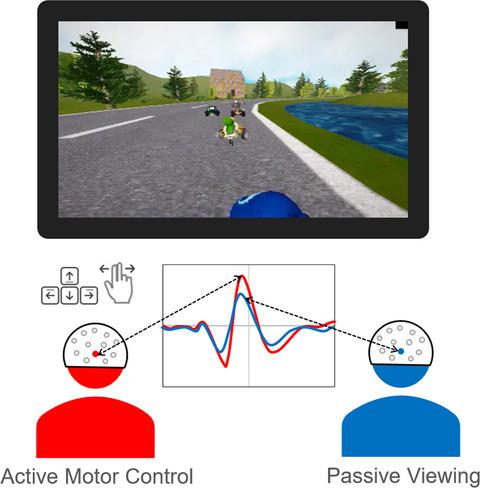当前位置:
X-MOL 学术
›
Eur. J. Neurosci.
›
论文详情
Our official English website, www.x-mol.net, welcomes your
feedback! (Note: you will need to create a separate account there.)
Visually evoked responses are enhanced when engaging in a video game
European Journal of Neuroscience ( IF 2.7 ) Pub Date : 2020-07-31 , DOI: 10.1111/ejn.14924 Jason J. Ki 1 , Lucas C. Parra 1 , Jacek P. Dmochowski 1
European Journal of Neuroscience ( IF 2.7 ) Pub Date : 2020-07-31 , DOI: 10.1111/ejn.14924 Jason J. Ki 1 , Lucas C. Parra 1 , Jacek P. Dmochowski 1
Affiliation

|
While it is well known that vision guides movement, less appreciated is that the motor cortex also provides input to the visual system. Here, we asked whether neural processing of visual stimuli is acutely modulated during motor activity, hypothesizing that visual evoked responses are enhanced when engaged in a motor task that depends on the visual stimulus. To test this, we told participants that their brain activity was controlling a video game that was in fact the playback of a prerecorded game. The deception, which was effective in half of participants, aimed to engage the motor system while avoiding evoked responses related to actual movement or somatosensation. In other trials, subjects actively played the game with keyboard control or passively watched a playback. The strength of visually evoked responses was measured as the temporal correlation between the continuous stimulus and the evoked potentials on the scalp. We found reduced correlation during passive viewing, but no difference between active and sham play. Alpha‐band (8–12 Hz) activity was reduced over central electrodes during sham play, indicating recruitment of motor cortex despite the absence of overt movement. To account for the potential increase of attention during gameplay, we conducted a second study with subjects counting screen items during viewing. We again found increased correlation during sham play, but no difference between counting and passive viewing. While we cannot fully rule out the involvement of attention, our findings do demonstrate an enhancement of visual evoked responses during active vision.
中文翻译:

从事视频游戏时,视觉诱发的反应得到增强
众所周知,视觉引导运动,而运动皮层也向视觉系统提供输入,这是鲜为人知的。在这里,我们询问运动活动期间是否对视觉刺激的神经处理进行了严格的调节,假设在从事依赖于视觉刺激的运动任务时,视觉诱发的反应会增强。为了测试这一点,我们告诉参与者,他们的大脑活动控制着一个视频游戏,实际上是在播放预先录制的游戏。这种欺骗对一半的参与者有效,旨在使运动系统参与进来,同时避免引起与实际运动或躯体感觉有关的反应。在其他试验中,受试者通过键盘控制主动玩游戏或被动观看播放。视觉诱发反应的强度被测量为连续刺激和头皮诱发电位之间的时间相关性。我们发现被动观看过程中的相关性降低了,但主动和假播放之间没有区别。假演奏过程中,中央电极上的Alpha-band(8–12 Hz)活性降低,表明尽管没有明显的运动,但运动皮层的募集。为了说明游戏过程中注意力的潜在增加,我们进行了第二项研究,研究对象在观看过程中对屏幕项目进行了计数。我们再次发现在假游戏过程中相关性增加,但是计数和被动观看之间没有区别。虽然我们不能完全排除注意力的参与,但我们的发现确实证明了主动视觉期间视觉诱发反应的增强。
更新日期:2020-07-31
中文翻译:

从事视频游戏时,视觉诱发的反应得到增强
众所周知,视觉引导运动,而运动皮层也向视觉系统提供输入,这是鲜为人知的。在这里,我们询问运动活动期间是否对视觉刺激的神经处理进行了严格的调节,假设在从事依赖于视觉刺激的运动任务时,视觉诱发的反应会增强。为了测试这一点,我们告诉参与者,他们的大脑活动控制着一个视频游戏,实际上是在播放预先录制的游戏。这种欺骗对一半的参与者有效,旨在使运动系统参与进来,同时避免引起与实际运动或躯体感觉有关的反应。在其他试验中,受试者通过键盘控制主动玩游戏或被动观看播放。视觉诱发反应的强度被测量为连续刺激和头皮诱发电位之间的时间相关性。我们发现被动观看过程中的相关性降低了,但主动和假播放之间没有区别。假演奏过程中,中央电极上的Alpha-band(8–12 Hz)活性降低,表明尽管没有明显的运动,但运动皮层的募集。为了说明游戏过程中注意力的潜在增加,我们进行了第二项研究,研究对象在观看过程中对屏幕项目进行了计数。我们再次发现在假游戏过程中相关性增加,但是计数和被动观看之间没有区别。虽然我们不能完全排除注意力的参与,但我们的发现确实证明了主动视觉期间视觉诱发反应的增强。











































 京公网安备 11010802027423号
京公网安备 11010802027423号